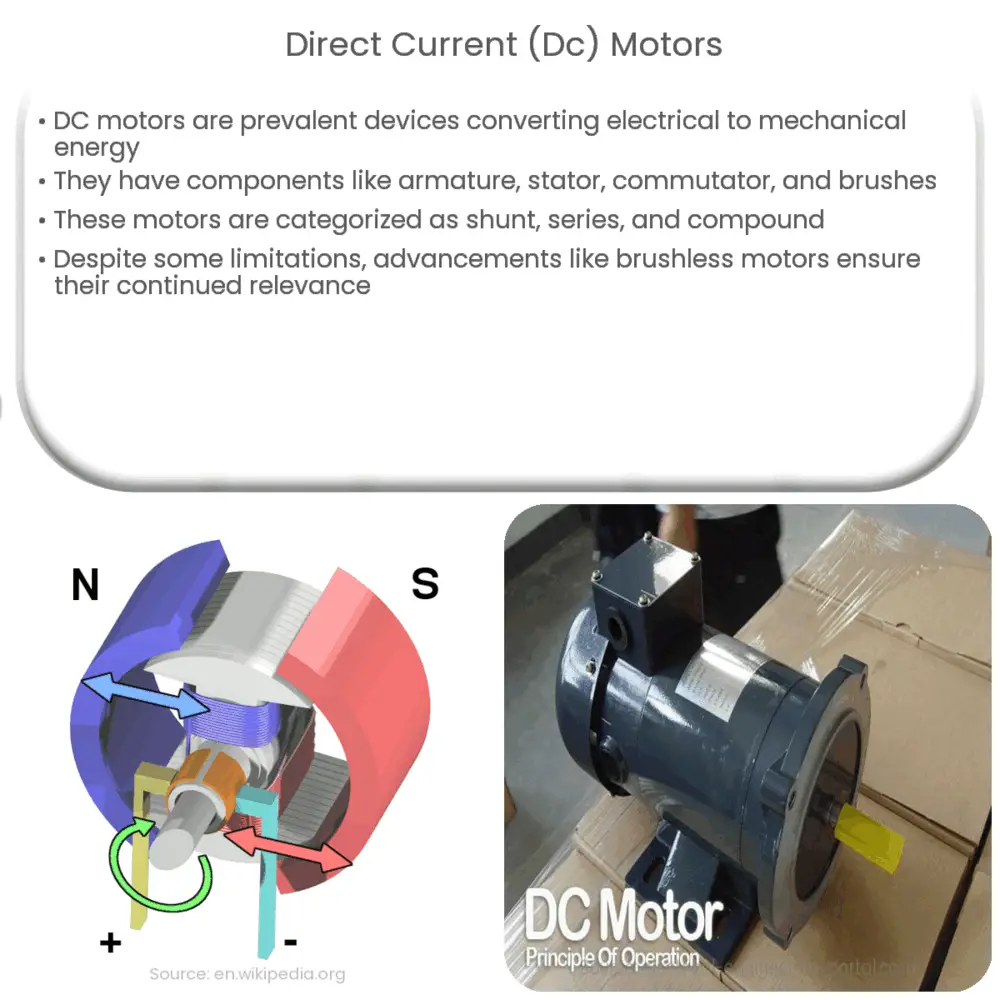Explore the inner workings of Direct Current (DC) motors, their types, applications, advantages, limitations, and future prospects.

Understanding Direct Current (DC) Motors
The wonders of technology have provided us with a multitude of fascinating devices, one of which is the Direct Current (DC) motor. Its ubiquity in a variety of appliances and machinery that we use daily might often go unnoticed.
The Principle of Operation
The DC motor is fundamentally an electric machine that converts electrical energy into mechanical energy. This transfiguration happens through the interaction of two magnetic fields, one generated by the current flowing through the armature, and the other is a static field produced by the stator.
Key Components of DC Motors
- Armature: The armature, also known as the rotor, is the rotating part of the DC motor. It has several coils wound around a metal core.
- Stator: The stator, as the name suggests, remains stationary and provides the magnetic field in which the armature rotates.
- Commutator: The commutator serves a crucial role in the DC motor. It’s a switch that reverses the direction of current flow every half cycle, ensuring the rotational motion of the armature.
- Brushes: These are used to maintain electrical contact with the rotating commutator.
Types of DC Motors
DC motors are broadly classified into three categories:
- Shunt DC Motor: In a shunt DC motor, the armature and field windings are connected in parallel. The speed of a shunt motor remains relatively constant, irrespective of the load.
- Series DC Motor: In a series DC motor, the armature and field windings are connected in series. This type of motor offers high starting torque and is often used in applications requiring such a feature, like electric trains.
- Compound DC Motor: The compound motor, as the name suggests, has a ‘compound’ winding, which is a combination of shunt and series windings. It carries the benefits of both shunt and series motors.
Advantages of DC Motors
DC motors have several significant advantages. They offer excellent speed control, which makes them ideal for various applications. Additionally, they provide high starting torque and are capable of adapting to sudden changes in load.
Applications of DC Motors
DC motors find themselves in a vast range of applications due to their versatility and functionality. Here are a few notable uses:
- Electric Vehicles: The high starting torque provided by DC motors makes them suitable for use in electric vehicles.
- Industrial Machinery: Their excellent speed control and high torque makes them a desirable choice for various industrial machinery, including lathes and drills.
- Home Appliances: Smaller DC motors are employed in common household appliances like fans, mixers, and even toys.
- Computer Systems: DC motors are integral in computer hardware. For instance, they are used to spin the hard drive disk.
Disadvantages and Limitations of DC Motors
Despite their numerous advantages, DC motors do have certain limitations:
- Maintenance: The presence of the commutator and brushes requires regular maintenance, as they are subject to wear and tear.
- Cost: The manufacturing costs for DC motors are generally higher than those of their counterparts, such as AC motors.
- Size: Owing to their design, DC motors are generally larger and heavier than other types of motors for the same power rating.
Future of DC Motors
Despite these limitations, the future of DC motors looks promising. With advancements in brushless DC motors, which eliminate the need for brushes and reduce maintenance, along with improvements in efficiency and control systems, DC motors will continue to be an integral part of our daily lives.
Conclusion
In conclusion, Direct Current (DC) motors play a crucial role in a wide array of applications, owing to their high starting torque, excellent speed control, and adaptability to load changes. Although they have certain limitations, ongoing technological advancements are addressing these challenges, ensuring their relevance in the foreseeable future. Whether it’s the electric vehicle you might be driving, or the fan cooling your room, DC motors are vital components that make modern life more convenient and efficient.

